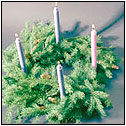Advent: Dates, Traditions, and History

The start of the Christmas season
|
Want to know what day Advent begins next year? Use the perpetual calendar.  The Advent wreath is a symbol of ongoing life. Related Links |
Advent is the period preceding the Christmas season. It begins on the Sunday nearest November 30, the feast day of St. Andrew the Apostle, and covers four Sundays. Because the day it begins changes from year to year, so does the length of each Advent season.
The word advent, from Latin, means “the coming.” For centuries, Advent has been a time of spiritual reflection as well as cheer and anticipation. Even as the Christmas season has become more secular-with advertisers urging holiday gift-givers to buy and buy some more-Advent still brings joy and the observance of ancient customs. Christian families find quiet moments lighting candles in the Advent wreath, and children use Advent calendars to count the days until Christmas.
The History of Advent
Advent has probably been observed since the fourth century. Originally, it was a time when converts to Christianity readied themselves for baptism.
During the Middle Ages, Advent became associated with preparation for the Second Coming. In early days Advent lasted from November 11, the feast of St. Martin, until Christmas Day. Advent was considered a pre-Christmas season of Lent when Christians devoted themselves to prayer and fasting. The Orthodox Eastern Church observes a similar Lenten season, from November 15 until Christmas, rather than Advent.
Many Christians still view Advent as a season to prepare for the Second Coming of Jesus. In the last fifty years, however, it has also come to be thought of as a time of anticipating the Nativity, on Christmas Day.
Advent Wreaths
Advent wreaths have their origins in the folk traditions of northern Europe, where in the deep of winter people lit candles on wheel-shaped bundles of evergreen. Both the evergreen and the circular shape symbolized ongoing life. The candlelight gave comfort at this darkest time of the year, as people looked forward to the longer days of spring.
Later, Eastern European Christians adopted this practice. By the sixteenth century, they were making Advent wreaths much as we know them today. An advent wreath traditionally contains four candles-three purple and one rose. Purple dyes were one so rare and costly that they were associated with royalty; the Roman Catholic Church has long used this color around Christmas and Easter to honor Jesus. The three purple candles in the Advent wreath symbolize hope, peace, and love. These candles are lit on the first, second, and fourth Sundays of Advent. The rose candle, which symbolizes joy, is usually lit on the third Sunday.
Sometimes a fifth candle is placed inside the Advent wreath. This candle is lit on Christmas Day. It is white, the color associated with angels and the birth of Jesus.
Because Advent wreaths are an informal celebration, not all are the same. Instead of purple candles, some people use blue, which recalls the color of the night sky before daylight returns. Others use all white candles.
Advent Calendars
An advent calendar is a card or poster with twenty-four small doors, one to be opened each day from December 1 until Christmas Eve. Each door conceals a picture. This popular tradition arose in Germany in the late 1800s and soon spread throughout Europe and North America. Originally, the images in Advent calendars were derived from the Hebrew Bible.
Considered a fun way of counting down the days until Christmas, many Advent calendars today have no religious content. Now, alongside traditional Advent calendars depicting angels and biblical figures are those whose doors open to display teddy bears, pieces of chocolate, or photos of pop stars.







